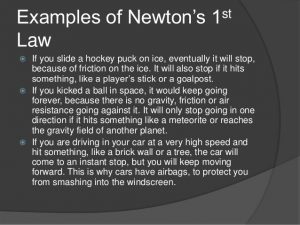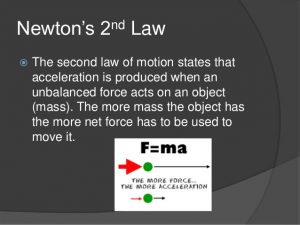As we all know, that every law in that exist in the Physics field of study is made based on phenomena that occur in our everyday life. So, it is normal that we found some implementations of Newton’s law in everyday life.
Before we discuss this even further about Newton’s law in everyday life, maybe there’s some of you forgot or even doesn’t know about the law made by an English scientist named Newton yet. Yep, Newton’s law or so-called Newton’s law of motion is basic law of classic mechanical physics that described the correlation between force that works in an object or motion that is caused.
Newton’s law of motion is so popular in the Physics’ world that it is named after its inventor, that is an English scientist with the name of Sir Isaac Newton. Overall, Newton’s law itself is divided into three laws, they are Newton’s first law, Newton’s second law, and Newton’s third law.
Every Newton’s discovery is related with the Physics’ law. His discovery was later distributed by his work entitled Philosophiae Naturalis Principia Mathematica that was published on July 5th, 1687. Newton’s work was remembered and still implemented until today.
After understanding the Newton’s law, there are some phenomenon around us that implemented all three Newton’s laws of motion. Here are the examples of newton’s laws in everyday life:
1. Newton’s First Law
 Newton’s first law of motion is also called as inertia law. This law states “if a force resultant of an object is equal to zero, then an object which initially is stationary will stay stationary. On the other hand, an object in which initially moves will stay moving in a constant velocity”. Newton’s first law of motion equation is F = 0.
Newton’s first law of motion is also called as inertia law. This law states “if a force resultant of an object is equal to zero, then an object which initially is stationary will stay stationary. On the other hand, an object in which initially moves will stay moving in a constant velocity”. Newton’s first law of motion equation is F = 0.
In general, Newton’s first law discuss the inert trait of an object which means that every object that tends to retain its position or place. In our everyday life, we can find that when a person stops or take breaks from a motorcycle or a bike. The momentum when taking a break suddenly and while action make the rider pushed forward. Other example, at the same time when a person steps on a pedal of a car, suddenly his/her body will be pulled back.
examples of newton’s laws in everyday life based on first law implementation:
- Simple pendulum swing
- A coin put on top of a paper on the table will stay in place when the paper is pulled
- Use of gear on a car engine
- Ball that rolls on a surface will roll on a constant velocity because its force resultant is zero
2. Newton’s Second Law
 Newton’s second law of motion states “the acceleration of an object is directly proportional with the total force resultant that works on that object and inversely proportional to the mass of an object”. The formula of Newton’s second law of motion is:
Newton’s second law of motion states “the acceleration of an object is directly proportional with the total force resultant that works on that object and inversely proportional to the mass of an object”. The formula of Newton’s second law of motion is:
F = ma
Where:
F is the net force on object
m is the mass of the object
a is the acceleration
As opposed from the Newton’s first law, the Newton’s second law correlates with the state of a moving object. Then the mass of an object and the force given to the object will be counted. In everyday life, we can find this second law when a person pushed his noodle cart in a certain strength. Then that cart will move with a certain acceleration. In a car that has the mass of 1 ton, then that car will accelerate with an acceleration of 1 m/s2.
Examples of newton’s law in everyday life based on second law of motion:
- A truck which carries less mass will have a bigger acceleration that a truck which carries more mass
- When we push a small and a big table, the small table will have a bigger acceleration so that the smaller table will get to the destination faster
- An adult who pushes a table will have a bigger acceleration than a kid who pushes a table who have a smaller force of pushing
3. Newton’s Third Law
 Newton’s third law of motion states “if an object gives force to another object then the object which receive the force will give force as big as it receives from the first object in the opposite direction”. Some implementation using Newton’s third law of motion are electric force and magnetic force. The formula of Newton’s third law of motion is:
Newton’s third law of motion states “if an object gives force to another object then the object which receive the force will give force as big as it receives from the first object in the opposite direction”. Some implementation using Newton’s third law of motion are electric force and magnetic force. The formula of Newton’s third law of motion is:
F1 = -F2
Where:
F1 is the force produced by the first object
F2 is the force produced by the second object
The third Newton’s law explained about the action-reaction pair of forces. An object that is given a force will create reaction towards us. In everyday life, we can find the application of the third law when a person is using a rowing boat. To make the boat move, an action is needed by the person to row the boat backward to create a reaction from the given force, that caused the rowing boat to move forward.
Another example of Newton’s third law can also be found in a water rocket toy. If you ever played with the water rocket, you will see water pressure that contains detergent in a high state, then when the water rocket cap opens, there’s an action in the form of water burst that bursts downward, so that it can create a reaction force to push the rocket to launch upward.
Examples of newton’s laws in everyday life based on third law of motion:
- Our hand feels pain when we hit the table because the table gives force as a reaction to our hand
- When someone swim, force given from his hand to the water results a reacting force from the water with the total force as big as his hand’s force, but in the opposite direction. So that he moves forward even though he swing his hand backward
You may also read about:
- Basic Laws of Chemistry
- Effects of Lawn Chemicals on Wildlife and Pets
- Gas Laws Definition, Formulas, and Examples
- List of Toxic Chemicals Used in Fracking
Those are some simple phenomenon that illustrated the implementation of Newton’s law of motion in our everyday life. You can also find other examples that usually occurs in everyday life that correlates with all three Newton’s laws of motion.

